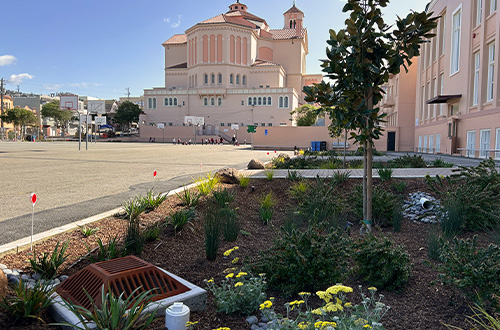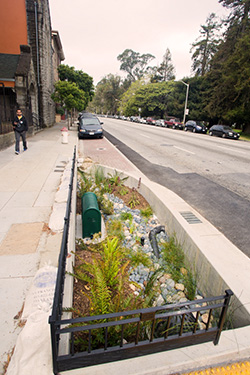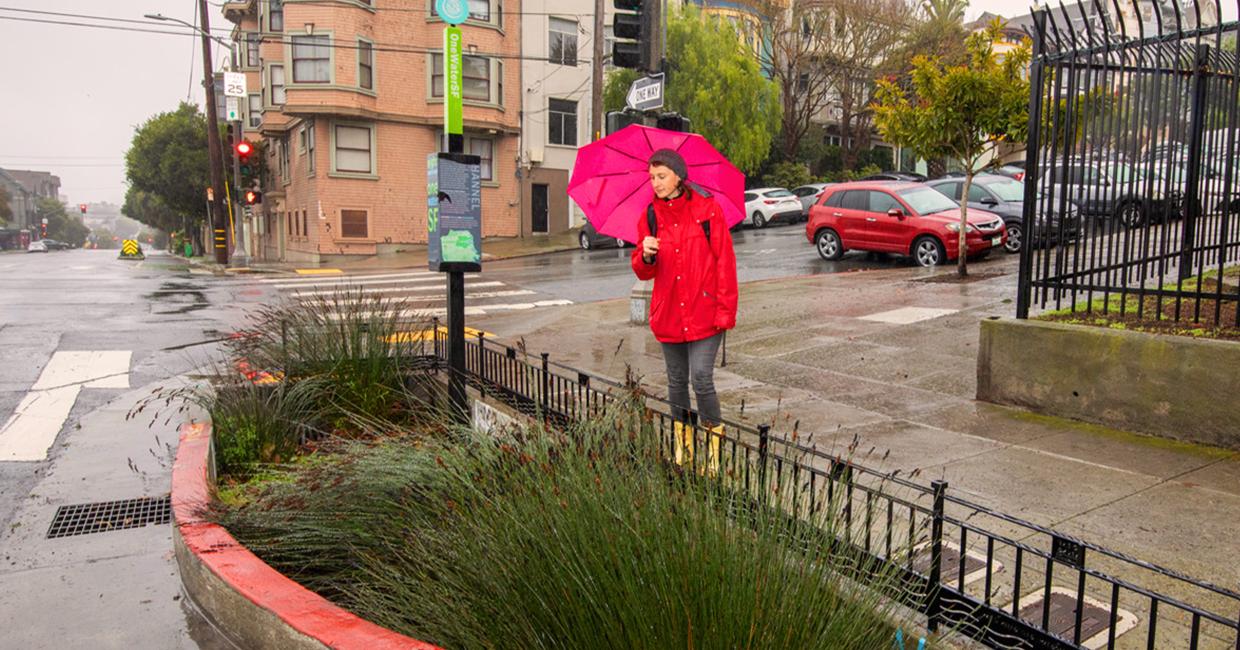It may look like and feel like a regular street in San Francisco, but you’re standing on permeable pavement or next to a rain garden – examples of green infrastructure that capture and filter stormwater, reducing the amount that enters our sewer system and removing pollutants that would otherwise reach our bay and ocean. These are found all over the City and help minimize flooding during severe storms, while enhancing community space and beautifying streets.
“Green infrastructure helps us harness our cityscape to fight climate change. By adding these green elements, we are strengthening San Francisco’s climate resilience and enhancing sustainability for everyone,” said Sarah Minick, Division Manager, Wastewater Enterprise (WWE) Urban Watershed Planning Division.
Ten billion gallons of rain fall on San Francisco every year, and the San Francisco Public Utilities Commission (SFPUC) has a goal to capture one billion gallons of stormwater annually with green infrastructure by 2050. The SFPUC is accomplishing this goal through private developers meeting the requirements of the Stormwater Management Ordinance, innovative partnerships between SFPUC and City partners building projects, and by providing incentives to property owners through the SFPUC’s grant programs.

By the end of 2024, 470 projects were capturing almost 290 million gallons. This includes 268 million gallons from 447 private projects, 17 million from 15 SFPUC/City projects, and four million from eight grant projects. The SFPUC is over a quarter of the way to the 1 billion goal and are on track to meet it by 2050.
Here are three types of green infrastructure you may notice around the City.
Rain Gardens
Rain gardens are shallow, planted basins that collect and absorb stormwater runoff. More than 10 million gallons of water have been captured in the hundreds of rain gardens that the SFPUC has installed and managed. As part of the SFPUC's Rain Guardians program, 143 volunteers have adopted a rain garden in their neighborhood and are keeping them free of trash and debris.
Permeable Pavement
Like many cities, most streets in San Francisco are covered in standard asphalt, a hard surface that water runs off of and prevents rain from reaching the earth’s soil. Permeable pavement, however, is concrete with a high permeability that allows rain to seep through the surface down to underlying layers of soil and gravel. In addition to reducing the runoff from the rain, permeable pavements can help filter out pollutants that contribute to water pollution. The SFPUC has installed permeable pavement on 17 city blocks in San Francisco.
Bulb-outs
Bulb-outs, also called curb extensions, provide additional pedestrian space at crosswalks. They enhance pedestrian safety by increasing pedestrian visibility, shortening crossing distances, and slowing turning vehicles. The SFPUC has embraced the opportunity to incorporate green infrastructure into 43 crosswalks throughout San Francisco.

Teamwork Makes the Dream Work
Designing and installing green infrastructure requires close coordination with the SFPUC Wastewater Enterprise and Infrastructure teams, San Francisco Department of Public Works, contractors, and other partners. These projects don’t just help manage stormwater—they also provide multiple added benefits like reducing urban heat, increasing biodiverse habitats for native pollinators, and adding urban greening to our City.
The SFPUC also offers several grant programs, including the Green Infrastructure Grant Program, which funds the design and construction of green stormwater infrastructure on large properties and in the public right-of-way, with the goal of reducing stormwater runoff while delivering public benefits that enhance the quality of life for all SFPUC rate payers. The SFPUC has also piloted the Green Infrastructure Grants for Homes program, exploring the potential to fund projects on small, residential properties.
On your commute tomorrow or on your next neighborhood stroll, keep your eye out for green infrastructure! You’ll start seeing the subtle ways the SFPUC is addressing climate change and using natural processes to reduce flooding.


